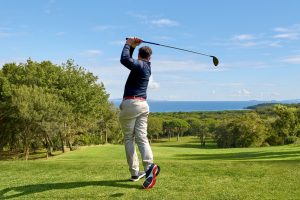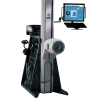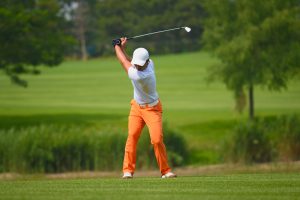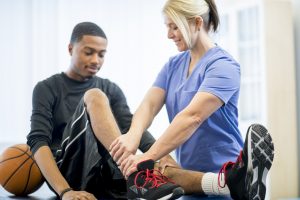
Avoiding Common Golf Injuries
Treatment GuidelinesSome of the most common golf injuries occur in the elbow, wrist, lower back, and shoulder. These injuries are mostly due to poor mechanics or overuse of weak, unstable muscles and joints. A strong golf swing transfers force through several joints and muscle groups between the foot and wrist.
With the Presidents Cup recent completion, and a few more weeks left in the season, taking care of your golf game is more than maintaining the equipment. Avoiding common golf injuries not only helps you finish this season strong, but also better prepares you for the next.
In 2015, approximately 2.2 million people decided to pick up golf as a leisure activity/hobby. For the younger population, golf participation has seen a 233% increase since 2013 (1). The game is growing steadily among many age ranges and other demographics. Viewership is also up significantly in the post “Tiger Woods era.” When seeing many of the professional golfers on television today, one thing that is quite noticeable is the fitness levels that these players possess. These golfers are able to generate remarkable club head speed even though many are not perceived to be that ‘explosive.’ One aspect that sets these golfers apart is their fitness routine. Not only does their routine lead to high club head speed, it also helps to reduce their risk of injury. After all, the golf swing is a full body, multi-dimensional, multi-plane movement that is repeated thousands of times in a given week.
Some of the most common golf ailments are elbow injuries, wrist injuries, lower back injuries, and shoulder injuries (2). These injuries are mostly due to poor mechanics or overuse of weak, unstable muscles and joints. The force that is generated in order to create power comes from a smooth transfer of motion through all the muscle groups between the foot and the wrist. Neglecting one major muscle group could be a recipe for injury while on the golf course. In 2015, it was documented that over 130,000 people were treated in Emergency rooms, doctors’ offices, and clinics for golf related injuries (3). Do not be one of these statistics……
Thankfully, there are countless websites dedicated to addressing proper fitness for the new or well-trained golfer. Good habits of going through a proper warm up and starting slowly can go a long way to preventing injury. Also beneficial is focusing on strengthening isolated movements first – targeting each joint individually. More and more clinics are offering services that help proactively strengthen these targeted areas
As isolated strength and range of motion improve, athletes should progress to more dynamic and full body linear movement, followed by rotational movements. Increasingly, Physical Therapy Clinics offer conditioning equipment like the PrimusRS, which takes muscle strengthening – isolated, linear, and rotational – as well as task simulation, including movements such as a golf swing, to the next level. BTE also provides tracking of session performance and progress over time to maximize gains. Dynamic movement utilizes both concentric muscle contractions (shortening of a muscle with resistance) as well as the highly valuable eccentric muscle contractions (lengthening of muscle tissue under resistance), such as those produced conditioning on the Eccentron. Balance exercises with explosive muscle actions are also appropriate to simulate golf movement (4).
Before hitting the links, it is always a good idea to have a plan for your body. Even if you must resort to the one and only Miguel Angel Jimenez’s routine, a proper warm up and fitness plan are key to injury prevention (5).
- https://www.forbes.com/sites/darrenheitner/2016/05/08/the-state-of-the-golf-industry-in-2016/#6f3806d433a6
- http://www.mayoclinic.org/healthy-lifestyle/fitness/in-depth/golf/art-20047434
- http://orthoinfo.aaos.org/topic.cfm?topic=a00137
- https://www.youtube.com/watch?v=B7oJgpLRCt8
- https://www.youtube.com/watch?v=RGiGEDnU6Tg





